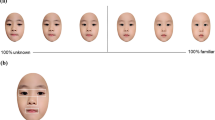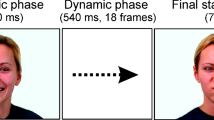Abstract
In the present study, we used a probe-detection task to compare attentional allocation to the eyes versus mouth regions of the face in high-functioning boys with autism relative to normal control boys matched for chronological age and IQs. We found that with upright faces, children from both groups attended more to the eyes region than to the mouth region, and to the same extent. This pattern of behavior was observed for not only initial orientation of attention, but also when enough time was provided for attention to be disengaged from its initial locus. The present findings suggest that atypical face processing in autism does not result from abnormal attentional allocation to the different face parts.


Similar content being viewed by others
References
Achenbach T. M. (1991). Manual for the Child Behavior Checklist/4–18 and 1991 Profile University of Vermont Burlington, VT
APA(2000). Diagnostic and statistical manual of mental disorders, fourth edition, text revision (DSM-IV-TR) American Psychiatric Association Washington, D.C
Baron-Cohen S. (1995). Mindblindness: An essay on autism and theory of mindBradford/MIT Press Cambridge, MA
Baron-Cohen S., Jolliffe T., Mortimore C., Robertson M. (1997). Another advanced test of theory of mind: Evidence from very high functioning adults with autism or Asperger syndromeJournal of Child Psychology & Psychiatry 38, 813–822
Baron-Cohen S., Wheelwright S., Jolliffe T. (1997). Is there a “language of the eyes”? Evidence from normal adults, and adults with autism or Asperger syndromeVisual Cognition 4, 311–331
Dalton K. M., Nacewicz B. M., Johnstone T., Schaefer H. S., Gernsbacher M. A., Goldsmith H. H., et al. (2005). Gaze fixation and the neural circuitry of face processing in autismNature Neuroscience 8, 519–526
Diamond R., Carey S. (1986). Why faces are and are not special: An effect of expertiseJournal of Experimental Psychology115, 107–117
Gauthier I., Nelson C. A. (2001). The development of face expertiseCurrent Opinion in Neurobiology 11, 219–224
Goren C., Sarty M., Wu P. (1975). Visual following and pattern discrimination of face-like stimuli by newborn infantsPediatrics 56, 544–549
Johnson M. H., Morton J. (1991). Biology and cognitive development : The case of face recognitionBlackwell Press Cambridge, MA
Joseph R. M., Tanaka J. W. (2003). Holistic and part-based face recognition in children with autismJournal of Child Psychology & Psychiatry 44, 529–542
Klin A., Jones W., Schultz R., Volkmar F., Cohen D. J. (2002). Visual fixation patterns during viewing of naturalistic social situations as predictors of social competence in individuals with autism Archives of General Psychiatry 59, 809–816
Lahaie, A., Mottron, L. T., Arguin, M., Berthiaume, C., Jemel, B., Saumier, D. (in press). Face perception in high-functioning autistic adults: Evidence for superior processing of face parts, not for a configural face processing deficit. Neuropsychology
Langdell T. (1978). Recognition of faces: An approach to the study of autism Journal of Child Psychology & Psychiatry 19, 255–268
Lord C., Risi S., Lambrecht L., Cook E. H., Jr., Leventhal B. L., DiLavore P. C., et al. (2000). The autism diagnostic observation schedule-generic: A standard measure of social and communication deficits associated with the spectrum of autismJournal of Autism Developmental Disorders 30, 205–223
Lord C., Rutter M., Le Couteur A. (1994). Autism Diagnostic Interview-Revised: A revised version of a diagnostic interview for caregivers of individuals with possible pervasive developmental disordersJournal of Autism Developmental Disorders 24, 659–685
Matsumoto D., Ekman P., (1988). Japanese and caucasian facial expressions of emotion (JACFEE) and neutral faces (JACNeuF) [CDs]Intercultural and Emotion Research Laboratory, Department of Psychology, San Fransisco State University San Fransisco, CA
Navon D., Margalit B. (1983). Allocation of attention according to informativeness in visual recognition Quarterly Journal of Experimental Psychology: Human Experimental Psychology 35, 497–512
Nelson C. A. (2001). The development and neural bases of face recognition Infant and Child Development 10, 3–18
Pelphrey K. A., Sasson N. J., Reznick J. S., Paul G., Goldman B. D., Piven J. (2002). Visual Scanning of Faces in AutismJournal of Autism and Developmental Disorders 32, 249–261
Posner M. I., Snyder C. R., Davidson B. J. (1980). Attention and the detection of signalsJournal of Experimental Psychology 109, 160–174
Ristic J., Mottron L. T., Friesen C. K., Iarocci G., Burack J. A., Kingstone A. (2005). Eyes are special but not for everyone: The case of autism Cognitive Brain Research 24, 715–718
Schultz R. T. (2005). Developmental deficits in social perception in autism: The role of the amygdala and fusiform face areaInternational Journal of Developmental Neuroscience 23, 125–141
Tanaka J. W., Gauthier I. (1997). Expertise in object and face recognition In Goldstone R. L., Schyns P. G., Medin D. L., (Eds.), Psychology of Learning and Motivation (Vol. 36)Academic Press San Diego, CA pp. 83–125
Teunisse J., de Gelder B. (2003). Face processing in adolescents with autistic disorder: the inversion and composite effectsBrain and Cognition 52, 285–294
van der Geest J. N., Kemner C., Verbaten M. N., van Engeland H. (2002). Gaze behavior of children with pervasive developmental disorder toward human faces: A fixation time studyJournal of Child Psychology & Psychiatry 43, 669–678
Vlamings P. H. J. M., Stauder J. E. A., van Son I. A. M., Mottron L. T. (2005). Atypical visual orienting to gaze- and arrow-cues in adults with high functioning autism Journal of Autism and Developmental Disorders 35, 267–277
Volkmar F., Lord C., Bailey A., Schultz R. T., Klin A. (2004). Autism and pervasive developmental disordersJournal of Child Psychology & Psychiatry45, 135–170
Yin R. K. (1969). Looking at upside-down facesJournal of Experimental Psychology 81, 141–145
Acknowledgement
This study was partially supported by The Israeli Science Foundation (grant No. 989/03).
Author information
Authors and Affiliations
Corresponding author
Rights and permissions
About this article
Cite this article
Bar-Haim, Y., Shulman, C., Lamy, D. et al. Attention to Eyes and Mouth in High-Functioning Children with Autism. J Autism Dev Disord 36, 131–137 (2006). https://doi.org/10.1007/s10803-005-0046-1
Published:
Issue Date:
DOI: https://doi.org/10.1007/s10803-005-0046-1




